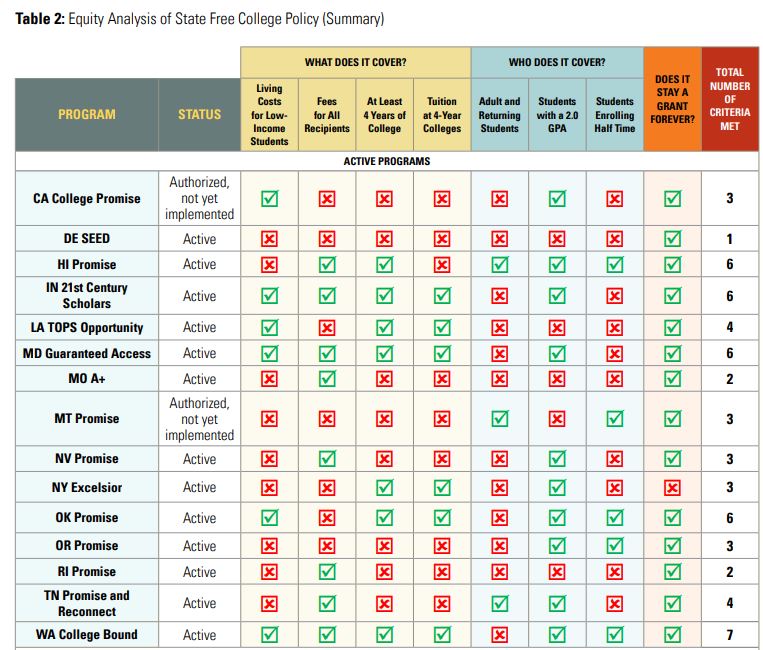You have /5 articles left.
Sign up for a free account or log in.
Tuition-free college programs enjoy wide public and political support, and their popularity is growing. But two new reports released today indicate that some programs do not guarantee the no-cost education promised to low-income students.
One report, from the Institute of Higher Education Policy, examines tuition-free programs in New York and Tennessee. Both programs have been widely heralded for attempting to make college more affordable, and Tennessee’s program was the basis for the Obama administration’s America’s College Promise initiative. But as last-dollar programs -- which only cover remaining tuition after other forms of federal and state aid have been used -- they often don’t cover the needs of the poorest students, who don’t have to pay tuition and fees but have housing, transportation, textbook and other college costs.
“We find in Tennessee and New York low-income students have an immense unmet need,” said Mamie Voight, director of policy research at IHEP. “While the lowest-income students have the greatest financial need, they are not receiving financial benefits through Tennessee Promise or New York’s promise.”
The second report, from the Education Trust, creates a framework for how voters, families and policy makers can examine statewide free college programs to determine whether they make college more affordable for low-income families and students of color.
“We’re happy people want to invest in opportunities,” said Tiffany Jones, director of higher education policy for Ed Trust and a co-author on the report. “But people assume free college means free, and they’re not understanding that too often these policies don’t cover the costs of attendance.”
Advocates of these tuition-free programs strongly disagree and say both reports don’t fully capture the benefits these initiatives and others in the respective states provide to low-income students.
Examining Tennessee and New York
The IHEP report examines the Tennessee and New York programs from the perspective of three types of students. One is a high-income student who is dependent on parental support. The two others are low-income students, but one is dependent on parental support and the other is financially independent.
The researchers found that before Tennessee Promise was established, low-income students at the state's two- and four-year institutions had more than $7,000 in unmet need, even after grants and scholarships. But even with the free college program, the low-income students' financial needs remained unmet, while the high-income student got an additional $1,500 in state support.
“The low-income independent and dependent student receives no money because it’s last dollar,” Voight said. “Their Pell Grant and other aid is already covering tuition … where they really face a notable financial hurdle is in living expenses.”
A Tennessee Board of Regents report from earlier this year found that 43.6 percent of Promise students received no funding from the program, even though nearly 98 percent of those students were Pell recipients.
Mike Krause, executive director of the Tennessee Higher Education Commission, disagreed with the findings of the reports. He said measuring the success of the state program on low-income students goes beyond finances. For example, in 2014, the year before the Promise program started, 45 percent of low-income students attended college. The following year, when the program was implemented, the college-going rate increased to about 54 percent. About 1,700 more low-income students have enrolled in college per year in the three years since the program started, he said.
“If the sole measure of success is how much money is awarded to students, I would question that as the most important policy question,” he said. “In Tennessee, our important policy question is, are we creating optimal access for students?”
He said many of these low-income students would not have even considered going to college if not for the existence of the Promise program.
“We welcome the conversation about serving underserved students and thank Ed Trust in the work they’re doing in this space,” Krause said. “I think we all need to have a clear conversation about the cost of college that extends beyond tuition, but a state stepping up to make sure tuition is met is commendable.”
Prior to New York’s Excelsior program, low-income students at the state’s colleges and universities had between $3,000 and $14,000 of unmet financial need. That need remains the same even with the program up and running, according to the IHEP report.
One good thing about New York’s program, however, is that there is an income cap that prevents high-income students from benefiting, Voight said.
A spokesperson in New York governor Andrew Cuomo’s office said both the Ed Trust and IHEP reports miss the full scope of the state’s aid programs.
“These reports are frankly uninformed and fundamentally flawed in that they ignore the totality of New York’s robust financial aid programs and instead attempt to analyze one program, the Excelsior Scholarship, in a vacuum without understanding how it interacts with the rest of the state’s free tuition financial aid system,” Don Kaplan, deputy communications director in the governor’s office, said in an email.
Kaplan pointed to New York’s Tuition Assistance Program, which provides about $1 billion in need-based aid to low-income students.
“Many, if not most of the students receiving TAP, have no need for the Excelsior Scholarship,” he said. “The bottom line is that New York is expanding college access and making it affordable for thousands of students who otherwise would be denied this life-changing opportunity to reach their full potential.”
But Voight said TAP has lost purchasing power in much the same way as the Pell Grant. The state has failed to increase the maximum TAP award for about 15 years, she said. Depending on the year a student enrolls, the maximum award can be up to about $5,000.
The state does provide a “tap-gap” tuition credit that covers tuition expenses above the maximum TAP for low-income students.
Measuring Tuition-Free Programs
An online poll conducted in June by Penn Schoen Berland, a market research firm, on behalf of the Campaign for Free College Tuition found 78 percent of respondents supported making college tuition free for anyone who is academically capable. That level of popularity is just one reason why candidates running for governor in Arizona, California, Florida, Maryland, Michigan and Minnesota have pitched tuition-free programs as part of their campaigns.
“Free is a message that works and is gaining traction, and it’s why we’re seeing so many of these programs pop up,” Voight said. “But the details of the programs really matter, and we want to make sure the way they’re designed is targeted in the best way possible so they’re truly free and making a difference for the students that need it.”
Officials at Ed Trust believe voters and students can better demand that these programs help low-income people if they have the tools to evaluate these initiatives.
Ed Trust researchers examined 15 existing statewide programs and 16 proposed programs that are designed to cover the cost of tuition, are entirely state funded and don’t require students to pursue specific areas of study. They then asked each program to meet eight different criteria to determine if they helped students financially and were racially equitable.
Those criteria included if the program covered living costs for low-income students, fees and at least four years of college and tuition at four-year universities and colleges. They also examined whether the programs were offered to adult and returning students, students with a 2.0 grade point average and part-time students, and whether the program converted to a loan at any point.
“Public voters can ask more critical questions of these policies to ensure they’re pushing policy makers to design a more affordable college for themselves and low-income students,” Jones said.
Of the 15 existing programs Ed Trust examined, only one met seven of the eight criteria -- the College Bound Scholarship in Washington State. It failed in only one area -- the scholarship does not cover adult and returning students.
Ed Trust also examined the states that include income caps and found that they tend to have more diverse beneficiaries and more closely mirror the demography of their state, said Katie Berger, a senior policy analyst at Ed Trust.
For instance, Indiana’s 21st Century Scholars Program, which has an income cap, has a 15 percent black and 10 percent Hispanic participation rate. The state’s population is 10 percent black and 7 percent Hispanic.
But in states that don’t restrict their free college programs, low-income students were less likely to benefit. In Delaware's program, 82 percent of free college students were middle or upper income, compared to 18 percent who were low income or Pell Grant recipients.
Meanwhile, there are other groups that policy makers should be cognizant of such as adult and returning students, Berger said, adding that 40 percent of college students today are over age 25.





